Halloween statistics 2019

Halloween 2019 saw a distinct drop in the number of groups and children seeking sweet treats. The low tally is certainly partially attributable to an increased security presence in the area, yet that alone would not account for the lower turnout. Children appeared to be able to freely move through the security point, some perhaps chose not to do so. A Thursday school night may have had some impact, there are surely other factors that impinged on the candy count this year. Total candy distributed fell from the running average of 473 down to 128 this year. Note that in 2017 and 2018 numbers were limited by candy exhausting prior to eight in the evening, with 2018 running out of candy by 7:49 PM. No "mega-groups" of youth were seen this year, groups of over thirty. The largest group came in at 24, and that was the sole outlier in the data for this year.





